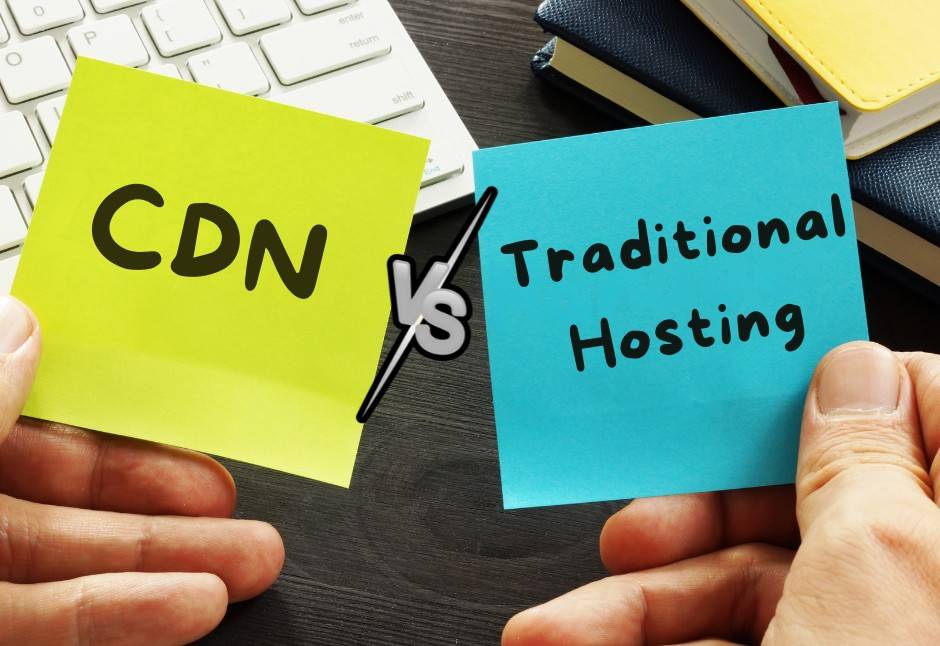
Remember the last time you clicked on a website and waited. That’s right. You sat there for a few seconds before giving up, just like everyone else does. I can almost guarantee that business lost not only your visit but probably hundreds of others that same day.
Developers do not obsess over website speed as a technical metric. It is the thin line between a visitor turning into a customer or bouncing off to your competitor. That is where this whole CDN versus traditional hosting conversation becomes more than just tech jargon.
What We’re Actually Talking About Here
Let’s begin with a clear understanding. Traditional web hosting is like having a single shop at one location – say, a store in Perth. Every customer who wants to visit your shop has to travel to Perth to get at what you’re selling. It seems reasonable, doesn’t it?
Imagine having the same shop with the same stock in Perth, Sydney, Melbourne, Brisbane, and even abroad. Customers just go to whichever location is closest. That’s basically what a content delivery network does for your website.
But here’s the thing that nobody really wants to tell you – you might not need one.
The Traditional Hosting Setup
Most Australian businesses begin with conventional web hosting and there is absolutely nothing wrong with that approach. Your website files are stored on a server somewhere, hopefully within Australia, and when someone enters your web address, their browser retrieves those files from that server.
For most SMEs, this approach works well enough. If you’re a local tradie servicing Perth or a boutique law firm in Sydney, traditional hosting with excellent web design practices can deliver perfectly acceptable speeds. Most of your customers are locals anyway.
Problems begin to show when:
- You get visitors from other states or countries.
- Your website traffic grows significantly.
- You have many images or videos.
- You run an eCommerce site with hundreds of product photos.
That’s when loading times can blow out. A visitor in Brisbane trying to access your Perth-hosted site might experience delays that feel like forever in internet time. And by forever, I mean anything over three seconds.
Enter the Content Delivery Network.
A CDN works by making copies of your website’s static files—images, CSS, JavaScript, video—and placing them on servers located all over the world. These are typically called edge servers or points of presence.
When someone visits your site, the CDN automatically delivers content to them from the server that is geographically nearest to them. That means faster load times with less strain on your primary hosting server and happy visitors who actually stay long enough for their attention span clock to run out.
Consider this: your main server is located in Perth. A user makes a request from Cairns. Instead of making the content travel thousands of kilometres, a CDN delivers it from Brisbane—much closer.
According to the Cybersecurity and Infrastructure Security Agency, a well-designed CDN “distributes content using servers placed at different locations, reducing effectively ‘the distance over which data has to travel.
Website Speed Optimisation That Actually Matters
Here’s where people get confused. They think slapping a CDN on their website is some magic fix that’ll solve all their speed problems. It’s not.
Many websites, despite having a CDN, still load slowly due to messy underlying code, unoptimised images, or excessive loading of unnecessary content on each page.
Website speed! We should observe the best practices of web design and development. At Slinky Web Design, we ensure the site is light, from proper image compression to clean codes and optimised database queries; hence, fast loading.
If you want to make your site perform well right from the beginning, this article on quick-loading websites contains core techniques related to best practices in speeding up a website that every web designer should know about.
A CDN boosts what’s already working well, but it doesn’t solve basic issues.
When You Actually Need a CDN
Let us be practical about it. These are the situations in which investing in a content delivery network makes real business sense:
You Are Running an E-Commerce Website
If you are selling products online, then speed directly impacts your conversion rate. A study proves that a one-second delay can reduce conversions by 7%. You’re dealing with product images, category pages, and checkout processes – a CDN can make a massive difference.
Further, most modern eCommerce sites serve customers at least nationally if not internationally. Why handicap yourself by making someone in Melbourne wait for files to travel all the way from Perth?
Your Website Gets Visitors from Multiple Locations
This one’s obvious but worth stating. If your analytics show visitors from different states or countries, a CDN helps deliver a consistent, rapid experience regardless of where they’re browsing from.
You’ve Got Heavy Media Content
CDN is more of a necessity than an option for such sites. Paying for a reliable CDN provider is worth it just for the savings on bandwidth costs, plus you get better backup options from different locations and many other technical benefits.
Your Site Experiences Sudden Traffic Spikes
Maybe you got lucky with some press coverage or ran periodic promotional offers. Large, sudden concurrent user loads typically overwhelm traditional hosting systems. A CDN shares that load among several servers so your main single-point server does not collapse exactly currently you need it most.
You’re Serious About SEO
Google’s own documentation states that page speed is one of the signals its algorithm uses to rank pages. In January 2018, Google announced that page speed would become a ranking factor for mobile searches starting later that year – specifically targeting websites with extremely slow experiences.
Will this result in improved organic search results? Indeed, if you’re competing for mobile traffic and your site is already among the fastest out there, thanks to a Content Delivery Network (CDN), then the answer is yes.
The Benefits You’ll Actually Notice
The obvious thing is speed. There are other benefits of a CDN that often go unnoticed.
Better Security
Most CDN providers today include protection as an integrated feature within their service offering. They can absorb and deflect malicious traffic long before it ever gets near your origin server. That’s worth having if you’re handling any kind of customer data or running payments through your site.
Reduced Server Load
When the CDN is serving all those images, videos, and file downloads, it leaves the main hosting server free to do what’s most important – process forms, handle database queries, and manage user accounts. This can help extend the life of your current hosting plan before you need to upgrade.
Improved Reliability
In the event your origin server fails for whatever reason, certain CDN configurations will be able to deliver cached content for your website. This is not an ideal solution, by any means, but it is a whole lot better than displaying an error page to your visitors.
Cost Considerations (Let’s Be Real)
CDNs do not come for free. Some of them charge based on the amount of bandwidth you use; some have monthly charges, and again, the premium services cost more.
For a small business website with moderate traffic, it could be paying nothing – some entry-level CDN services are free – to a few hundred dollars per month for more comprehensive coverage.
Is it worth it? Depends on what you’re trying to accomplish.
If faster loading times mean more sales, a better user experience, or improved search rankings that bring more business, then yes. The return on investment can be substantial.
Are you running a simple informational website for a local business that gets a few hundred visitors per month, all from your area? Maybe not yet. First, focus on the other optimisation strategies.
The Technical Side (Without Making Your Head Hurt)
Setting up a CDN requires your domain DNS to point to the CDN provider, who then sits as a proxy between the visitor and your real hosting server. Most CDN services make this effortless.
Some web hosts provide this feature as part of their overall package. If your web host is one of these providers, you should enable it.
The really good thing in today’s web development is that platforms such as WordPress have plugins which make the integration of a CDN almost effortless. Set it up once and, yes, it works perfectly in the background.
What About Traditional Hosting Improvements?
Consider what else might improve your website speed before jumping straight to a CDN solution:
- Upgrading to better quality hosting
- Implementing proper caching
- Optimising images and media files
- Minimising HTTP requests
- Using efficient code and removing unnecessary plugins
Occasionally these changes, implemented by experienced web designers and developers, can deliver the speed improvements you’re looking for without the ongoing CDN costs. However, a properly set up and configured CDN is often still necessary to make websites lightning fast.
If you are evaluating your present web hosting setup or considering an upgrade, this guide will help you make the right choice of a good web hosting provider by walking you through the qualities to look out for.
Making the Decision
Here’s my simple advice. If you are developing a new website or doing a major overhaul, discuss with your web design agency about integrating the capabilities of CDN from the beginning. It is much easier to have it implemented initially than to come later to add it.
The team at Slinky Web Design first understands the real needs of its clients. We do not attempt to force any irrelevant solution. If a certain local Perth business does not need CDN distribution, we inform them about it and advise them to channel that part of the budget elsewhere.
However, for companies with a national reach, international visitors, or heavy media content, we will design the site’s architecture to function optimally with CDN technology. It is about building websites that serve your business goals and not just implementing every trendy tech solution going around.
Check out some examples of high-performance websites we have built for completely unique Australian businesses in our web design portfolio.
The Future Landscape
Content delivery networks are available and affordable to all businesses. What was once the exclusive domain of large corporations has become feasible for smaller firms as well.
We are also finding hosting providers building CDN-like capabilities directly into their infrastructure. The distinction between ‘normal hosting’ and ‘CDN-enhanced hosting’ is getting ever harder to define.
My prediction? Give it a few years and having CDN capabilities will be as standard as having SSL certificates today (which, by the way, your website definitely needs if it doesn’t have one already).
Wrapping This Up
The debate between CDN and traditional hosting is not a binary decision. It’s about understanding what your website needs to deliver optimally for your particular audience and business objectives.
Traditional hosting still serves the purpose for most businesses in Australia. A CDN provides an additional layer of performance optimisation that becomes useful and necessary when factors such as geography, traffic, or content demand justify the investment. What’s the best way to go about it? Build your site right, with clean code, optimised media, and decent hosting. Apply a CDN when business growth requires one.
Speed matters; your visitors expect it, Google rewards it and your competitors are probably already working on it. We help Perth businesses and companies across Western Australia make these decisions based on real data and genuine business needs.
Your website should make you money, serve your customers, and grow your brand.









